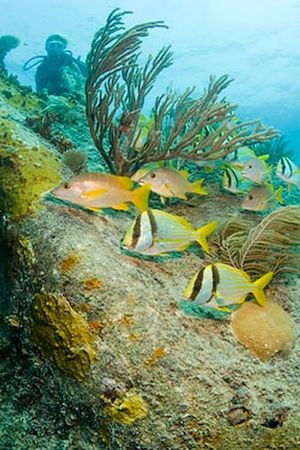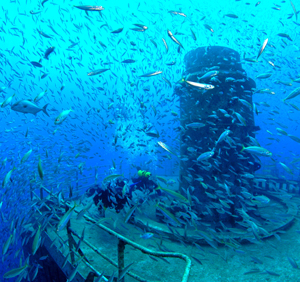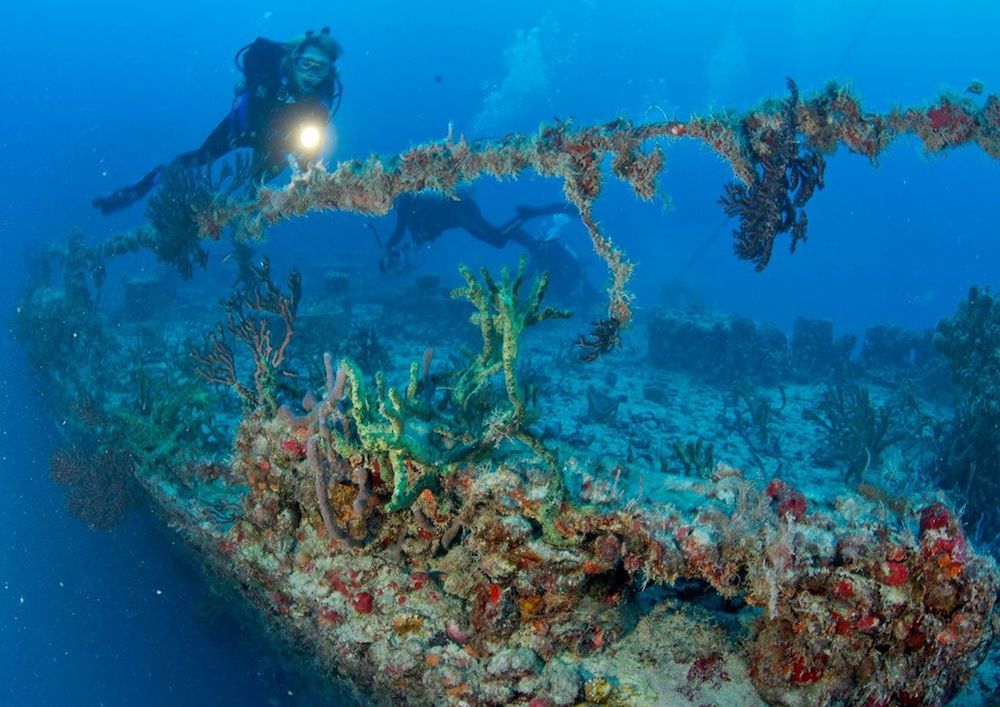If you’re a diver planning a Florida Keys vacation, you can anticipate days of world-class underwater adventure — exploring a fascinating shipwreck trail that stretches from Key Largo to Key West within the Florida Keys National Marine Sanctuary.

The Benwood, a highlight of the Florida Keys Shipwreck Trail, is among the Keys’ most popular dive sites. (Photo by Bob Care, Florida Keys News Bureau)
The trail doesn’t just feature long-ago wrecks (like the “ghost” of a majestic Spanish galleon dating back to the 1700s). In recent years, these historic gems have been joined by ships intentionally sunk to create artificial reefs that are now home to many varieties of fish and coral.
The marine sanctuary, which has been protecting the waters surrounding the Keys since 1990, spotlights nine wrecks on its online Shipwreck Trail — and provides detailed information on the history and archeology associated with each one.
The featured ships are the Adelaide Baker, Amesbury, Benwood, City of Washington, Duane, Eagle, North America, San Pedro and Thunderbolt.
The Benwood, lying in 25 to 45 feet of water off the coast of Key Largo, is one of the more accessible shipwreck dives in the Keys. A merchant marine freighter, it sank in 1942 after a nighttime collision with another vessel.
The Benwood is now one of the most popular dive sites in the Keys. Typically filled with fish, it’s a good choice for novice divers and snorkelers.
The oldest wreck on the sanctuary’s trail is the San Pedro, which sank in 18 feet of water just south of Indian Key near Islamorada during a 1733 hurricane. The ship was part of a Spanish treasure fleet heading from Cuba to Spain.
Discovered in 1960, the San Pedro site was heavily salvaged for the riches the galleon carried. Even so, the allure of possible remaining treasure still brings divers and snorkelers to explore the area now designated San Pedro Underwater Archaeological Preserve State Park.

Thunderbolt, originally named Randolph, was sunk as a dive attraction off Marathon in 1986. (Photo by Stephen Frink)
Four of the ships on the sanctuary’s Shipwreck Trail also appear on the Florida Keys Wreck Trek.
If you want to follow that trail, you can download (or request from your dive operator) a Wreck Trek logbook to preserve the details of your dive experiences.
The nine ships on the trek are the Spiegel Grove, Duane and Benwood off Key Largo; the Eagle off Islamorada; the Thunderbolt off Marathon; the Adolphus Busch off the Lower Keys; and Joe’s Tug, the Vandenberg and the Cayman Salvager off Key West. All except the Benwood were deliberately sunk to serve as artificial reefs.
Thunderbolt was donated to the Florida Keys Artificial Reef Association by Florida Power and Light Co., which purchased the vessel in 1961 for use in researching electrical energy and lightning strikes — thereby inspiring its name. Thunderbolt lies in 120 feet of water 4 miles south of Marathon and was intentionally sunk in 1986.
One of the stars of the Wreck Trek is the 510-foot-long Spiegel Grove, a former U.S. Navy landing ship dock.
Not only is it the third-largest vessel ever sunk as an artificial reef, but its 2002 sinking off Key Largo went famously awry — ultimately leaving the ship lying on its starboard side, instead of upright as intended.

Fish flock to the site of the Vandenberg not long after the ship was intentionally sunk as an artificial reef. (Photo by Don Kincaid)
However, in 2005 strong ocean currents from a hurricane that brushed the Keys shifted the ship to the planned upright position. Today the Spiegel Grove’s superstructure is visible starting at 45 feet, while the keel is settled on the bottom at 130 feet.
The 523-foot-long Gen. Hoyt S. Vandenberg became the world’s second-largest vessel to be deliberately sunk as an artificial reef.
Located in nearly 150 feet of water approximately 7 miles south of Key West International Airport, the Vandenbergis the southernmost component of the Florida Keys Wreck Trek and is filled with abundant sea life.
Only a few ships in Florida Keys waters carried gold or other rich cargoes.
But from Spanish galleons to those more recently scuttled as artificial reefs, they all offer treasures for divers and snorkelers: prized and colorful marine life, a unique glimpse into history, and an appreciation of the Keys’ one-of-a-kind maritime heritage.

